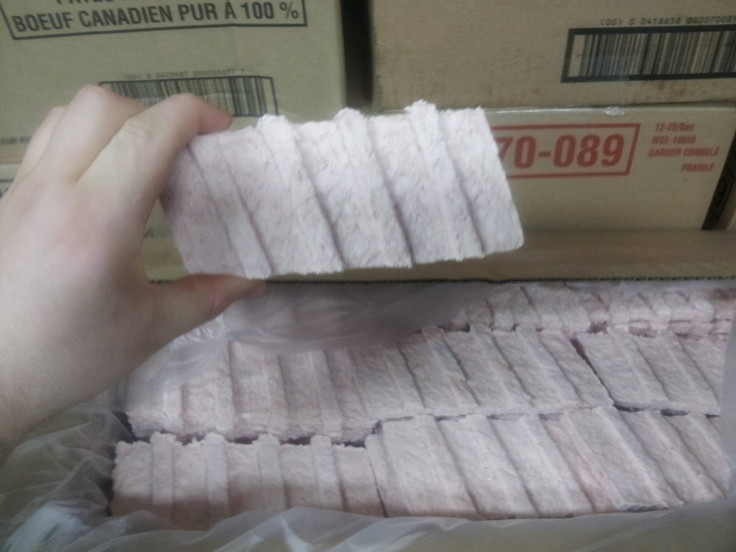McDonald’s Frozen McRib Photo Goes Viral: What’s The Frozen Pork Meat Really Made Of?

The famous McRib is back, and it’s making headlines again — though not for what you may think. This time, everyone is questioning: what’s really in the rib-shaped pork meat?
An image of the frozen McRib was posted on Reddit two days ago by a user who claimed their friend worked at McDonald’s. In the photo, an unidentified hand holds up a white, frozen block that looks more like clay than meat. While the image has horrified some, others remain stalwart fans, noting that McDonald’s meat production isn’t as bad as everyone makes it out to be.
The McRib, which is only available for a short time in the U.S. and Canada, consists of a slab of boneless pork meat that is shaped to give the appearance of a small rack of ribs, slathered in BBQ sauce, topped with pickles and onions, and sandwiched between hoagie buns. On its website, McDonald’s lists 101 reasons why you should try a McRib sandwich. Number 13 says, “Tender pork [minus] bones [multiplied by] tangy sauce = yummy. Seriously, a first grader could do that math.” And number 34 notes that the McRib “makes headlines each and every time it comes back.” But could the headlines this time around affect its popularity and devoted following?
What’s Really In It?
According to Brand Eating, there are about 500 calories in a McRib, 240 of which are fat calories. Out of the 26 grams of fat in the item, 10 grams are saturated fat. The McRib boasts about 980mg of sodium, 11g of sugar, and 22g of protein.
McRib meat is a form of “restructured meat product,” which was developed by University of Nebraska Professor Richard Mandigo decades ago. “[T]hat pork patty drenched in barbecue sauce actually represents one of the greater innovations in meat science of the last century,” Peggy Lowe of NPR writes. Mandigo, who is often credited with creating the McRib, told NPR that he merely came up with the process of binding meat together, but that McDonald’s chose the shape. “All we did was reuse the technology that had been around for hundreds of years and emphasized that we could shape products to shapes people wanted,” Mandigo said.
Though it’s shaped to look like ribs, the meat isn’t actually rib meat. “Primarily, it’s shoulder meat,” Rob Cannell, director of McDonald’s U.S. supply chain, told Maxim in 2009. He explained that the McRib is made in “large processing plants — lots of stainless steel, a number of production lines, and these long cryogenic freezers. The pork meat is chopped up, then seasoned, then formed into that shape that looks like a rib back. Then we flash-freeze it. The whole process from fresh pork to frozen McRib takes about 45 minutes.”
And of course, McDonald’s released a statement after the photo went viral:
There are few things more legendary at McDonald’s than the McRib…One reason our customers love the McRib is its fun and wonderful shape. Just like a burger patty is formed to be round and flat, we form the iconic McRib in the shape of traditional ribs. We then flash freeze the patty to seal in flavor and freshness, just like you freeze meat in your own freezer, before going to our restaurants. The McRib is also known for its iconic taste, which is why we use a quality cut of pork — pork shoulder — to give our McRib lovers a thicker, meatier McRib experience.
But TIME notes that it’s not as simple as just pork shoulder — there are some 70 ingredients in the McRib, including azodicarbonamide, ammonium sulfate, and polysorbate 80. Azodicarbonamide has actually been banned in Europe and Australia as a food additive, and has been used in the making of foamed plastics and shoe soles. But the McRib contains such small amounts of these chemicals, they should not pose any direct health risk, as the food additive is regulated and approved by the FDA.
The McRib suffered a minor scandal in 2011, when the pork supplier of the McRib — Smithfield Foods — was under scrutiny from the Humane Society of the United States (HSUS) for inhumane treatment of its pigs. HSUS filed a legal complaint, alleging that the hogs were raised in “hellish” conditions and were not receiving basic needs. However, overall, McDonald’s is known to have strict standards for both its production and animal welfare.
And McRib fans, meanwhile, may not be scared off that easily by a photo of frozen meat. “Oh, no. It’s raw, frozen meat that is perfectly edible,” one Reddit user writes. “Run for your lives.”



























